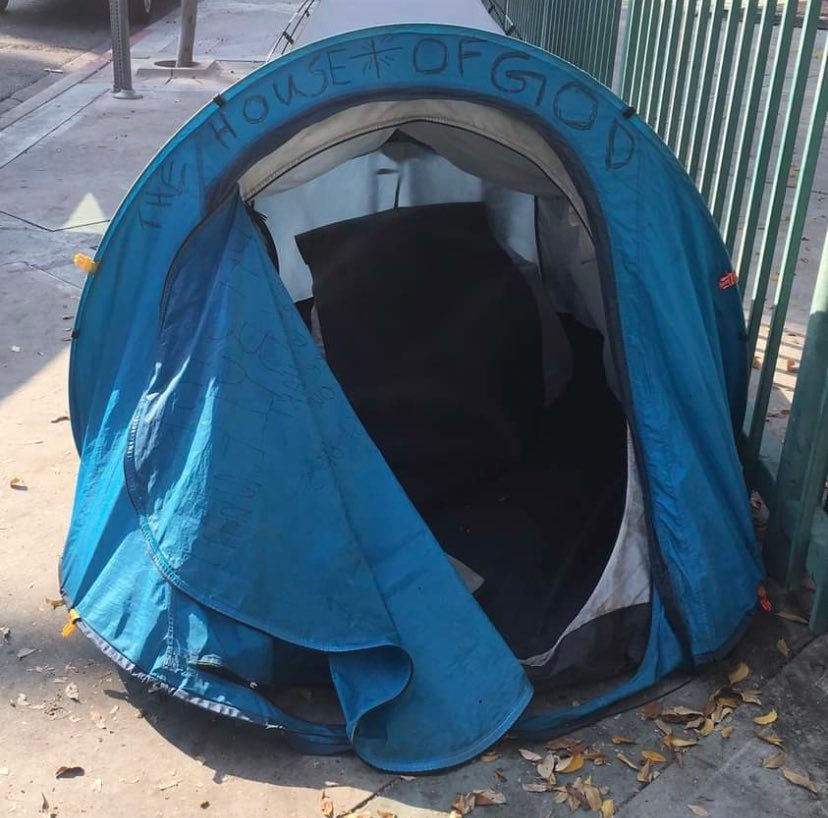Hygge: a cozy quality that makes a person feel content and comfortable.
“During the long, dark winters when Danes retreat inside their homes, hygge is what brings them a great sense of comfort and joy.”—Mary Holland
“Homelessness will be ended not because a few politicians have epiphanies and make new policies. It will be because communities, housed and unhoused together, force change because they won’t tolerate the status quo any longer.” —Kevin Nye from Grace Can Lead Us Home
Motels4Now in South Bend, Indiana.
I visited them last winter and was warmed by the imaginative vision on display through the good work they’re doing, and the community the residents are forming.
I wore an old t-shirt to work yesterday. The Future is Cozy in black block letters, courtesy of our reigning Queen of Home, The Nester. I’m not sure what caused me to pull it from the stack, other than 1) it’s exceedingly soft and 2) my mind always turns to coziness this time of year. A young co-worker who recently got his first apartment after a brutal stretch without housing questioned me. “Cozy? But aren’t we heading to WWIII? Aren’t we about to get nuked? I don’t think the future is cozy.”
For a split second, I regretted wearing it. Maybe it was naive, or flippant, or even cruel. I’d been side-eyed about it once before by a woman on the internet whose skepticism I understood but who, like me, pushes a button on her wall whenever she feels a chill inside her sturdy walls. Beep beep, no big deal. This critique landed with more impact. But my answer to both of them was the same. “This is my hope and what we should work towards. I want a world where it’s true, a future where everyone is cozy.”
Back at home, Silas “fulfilled” (he prefers the most professional language available to him) orders for his soy candle business. A student of his mother, he knows it’s all about vibes. Scents of vanilla, cinnamon, clove, and juniper waft up from the basement, comforting and warm. It’s November, after all. It’s what we all want.
From the moment the temperature dips, I want to feel tucked-in, toasty, and content. I make soup (to Ruby’s great angst1), snug lamps into empty corners, add extra blankets, light candles, and listen to music that reminds me of foggy-windowed cafes. But from the periphery of my consciousness the what-abouts tap-tap-tap, like a child desperate for a parent’s attention. “Hey mom. Mom. Mom. Bro.” Only in this case it needles, “What about him? What about her? What about that family who slept in their ground-down SUV for months on end?”
As you probably expect, I have no answers except our tried-and-trues:
Pay attention.
Live palms-up.
Feel everything.
November is National Homelessness Awareness month. I only learned this a few days ago, but it makes perfect sense. In a season where most of us yearn for comfort and companionship, where we take a harder turn toward gratitude, where commercialism attempts to badger us into numbed-out, frazzled, toxic positivity, it is for our good - both personal and collective - to feel the weight of a world that shivers through winter.
With any luck, that chill will rattle our own comfy-cozy bodies as many times as it takes to move us. As “humans, merely being2”, knit together by water, fat, protein, and the strong ties of love3 , we journey toward our best selves when we relentlessly place our bodies on the pathway of feeling something.
This season, may we ground our hearts in the agonizing threshold of snug delight and wind-burned reality. And may what we feel there move us toward a cozier future for everyone, no exceptions.
The Real Reason I Brought You Here Today
I recently read Kevin Nye’s Grace Can Lead Us Home: A Christian Call to End Homelessness cover-to-cover, underlining and highlighting a good chunk of the text. If you care about your unhoused neighbors at all, this is required reading. It’s compelling, compassionate, and pulls no punches. Certain quotes are still knocking around inside me and forever reshaped some of the ways I see unhoused people, people with addiction, and even God.
I reached out to Kevin for a whistle-stop interview here at The Soup and he was game!
Onto the interview…
photo courtesy of Kevin Nye, Hollywood, CA
Shannan: Kevin, I can't say enough about your book, Grace Can Lead Us Home. I read every word and bled my highlighter dry. I hope everyone reads it! Until they do, can you share a few sentences about your work and what ultimately led you to write this book?
Kevin: Certainly! There are two sides to my work that intermingle but are separate. There's my day job, where I work at a nonreligious nonprofit in Minneapolis that is directly addressing homelessness. The other side is the side I'm doing here: writing, preaching, speaking, and overall advocating for Christians to interact with homelessness differently--specifically in ways that align with our theological commitments about also truly work for ending homelessness. I went to school to be a pastor before ending up in this work, so this side brings together the things I care about and think about the most, and that's what initially inspired the book.
Shannan: In your opinion, why does compassionately and effectively addressing homelessness seem to be particularly challenging for Christians, given what we know about God's heart for the poor and undervalued?
Kevin: There are deeply held myths about homelessness and poverty that color not only the way we see people in these situations but also the way we interpret scripture. It makes it so that we can read an entire Gospel about Jesus and his heart for the poor and marginalized, but somehow think he was talking about someone else besides the people we see and encounter every day. The central myth that we have internalized is that people who are poor or unhoused somehow deserve it--that their plight is their own fault and they bear sole responsibility. Most people wouldn't say this outright, but it emerges in many different ways. (I.e. believing that everyone on the streets is a drug addict, or arguing that people "just want to be homeless.") Sadly, it's been shown that these attitudes are even more prevalent in Christian spaces than outside them. That's why my book is ultimately about grace--God doesn't interact with us based on ideas of "deservedness," so why do we?
Shannan: As we head into winter and the holiday season, what's one small step we could take as we seek to reorient our perspective toward our unhoused neighbors? Is there a good starting point that comes to mind? (Besides reading your book!)
Kevin: I appreciate the framing of this question. Very often I get asked "What can I do today/tomorrow to help address homelessness?", and it's hard to answer. It's a big problem that requires big, collective solutions. But we won't recognize them or support them when they come around if we haven't done the internal reorientation work---truth-telling that counters the myths we've inherited.
I'm a big believer in the transformative power of language. There's a lot of disagreement in the services world about whether to say "homeless" or "unhoused" or "people experiencing homelessness"--but I think the most helpful change my family made is referring to them as "neighbors". This is language that even my three-year-old understands and is therefore learning to look at homelessness the same way we look at anyone in our community. Whether we realize it or not, this same internal shift happens when we change our language. It's like becoming fluent in another language--eventually you start to think and even dream in new ways.
Another small but momentous shift is learning people's names. If you find yourself interacting with anyone experiencing homelessness, on purpose or by accident, ask them their name and commit to remembering it (even if you're not going to give them money.) It's a more humanizing experience for everyone involved, and the next time you see them you're more likely to think "That's Steve" than "There's that homeless guy." That's the start of relationship and the basis for community, which to me is the ultimate goal.
I hope you’ll buy a copy of his outstanding book and read it. Gift it to your pastor. Start a community book club.
I also highly recommend his Substack titled, “Who is My Neighbor.” Sign up here and consider reading this recent post, The Widows Might. (I teared up reading it.)
Speaking of coziness…
It’s time to defrost your turkey and buy your pears (TODAY!) for our favorite Thanksgiving classic, the too-easy pear tart. As I wrote all the way back in 2013, “It's subtle. It's fancy. It's classic. It's the Natalie Portman of the dessert buffet.” (But only if your pears are ripe.)
Pear & Cream Cheese Tart
1 stick of butter, softened
1 cup sugar, divided
1 cup flour
1 pkg (8 0z) cream cheese, softened
1 egg
1/2 tsp vanilla
1/2 tsp cinnamon
1/4 tsp ground nutmeg
3 thinly sliced pears, peeled
Preheat oven to 425.
Beat butter and 1/3 cup sugar until light and fluffy. (I do this in my Kitchenaid mixer.)
Add flour, mix well.
Spread firmly onto bottom and up the sides of a springform pan (I push it about 3/4 of an inch up the sides of a 10-inch pan. A 9 inch pan is a more standard size, so you could push up about an inch.)
Beat cream cheese and 1/3 cup sugar in same bowl.
Add egg and vanilla, mix well.
Spread evenly over crust.
Combine remaining 1/3 cup sugar with cinnamon and nutmeg.
Toss sliced pears with sugar mixture until covered.
Arrange pears in concentric circles on top of cream cheese filling, starting with the outside and working in.
Eat any left-over cinnamon sugar pears.
(Do not share.)
Bake 10 minutes then reduce to 375 and bake 25 minutes or until golden brown at edges and the middle is set.
Cool on wire rack.
Remove outside of springform pan.
Refrigerate tart for a few hours until cool and well set.
Last Winter, Ruby confessed she finds soup - all soup - “depressing.” We are trying to work through it.
Colossians 2:2







I love this post. Thanks, Shannan, for always afflicting me in my comfort. Kevin, that one suggestion of learning someone's name is helpful. I'm part of an inner city after school program, where we help with homework, give snacks, and help the students' families with a food pantry and clothing closet. Yet I still feel I'm taking baby steps. It's easy to feel overwhelmed. BUT GOD.
Thank you so much. Bought the book and subbed to Kevin. So important...and I feel so helpless.